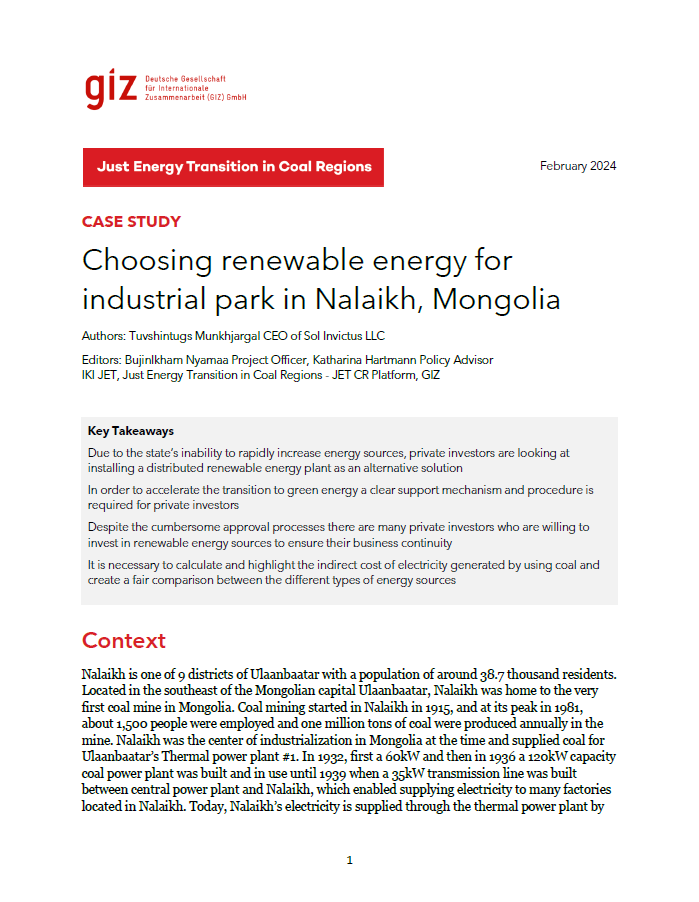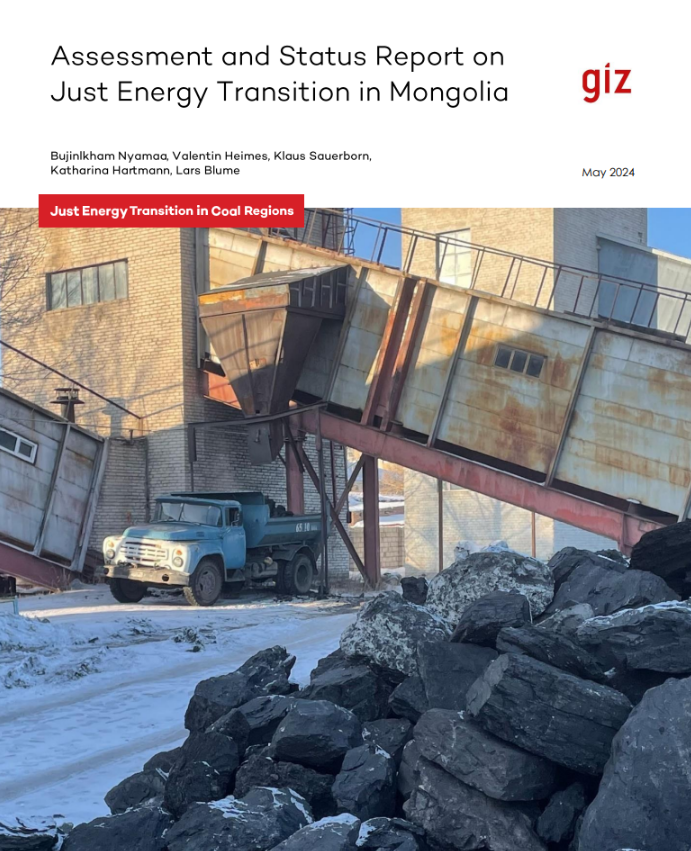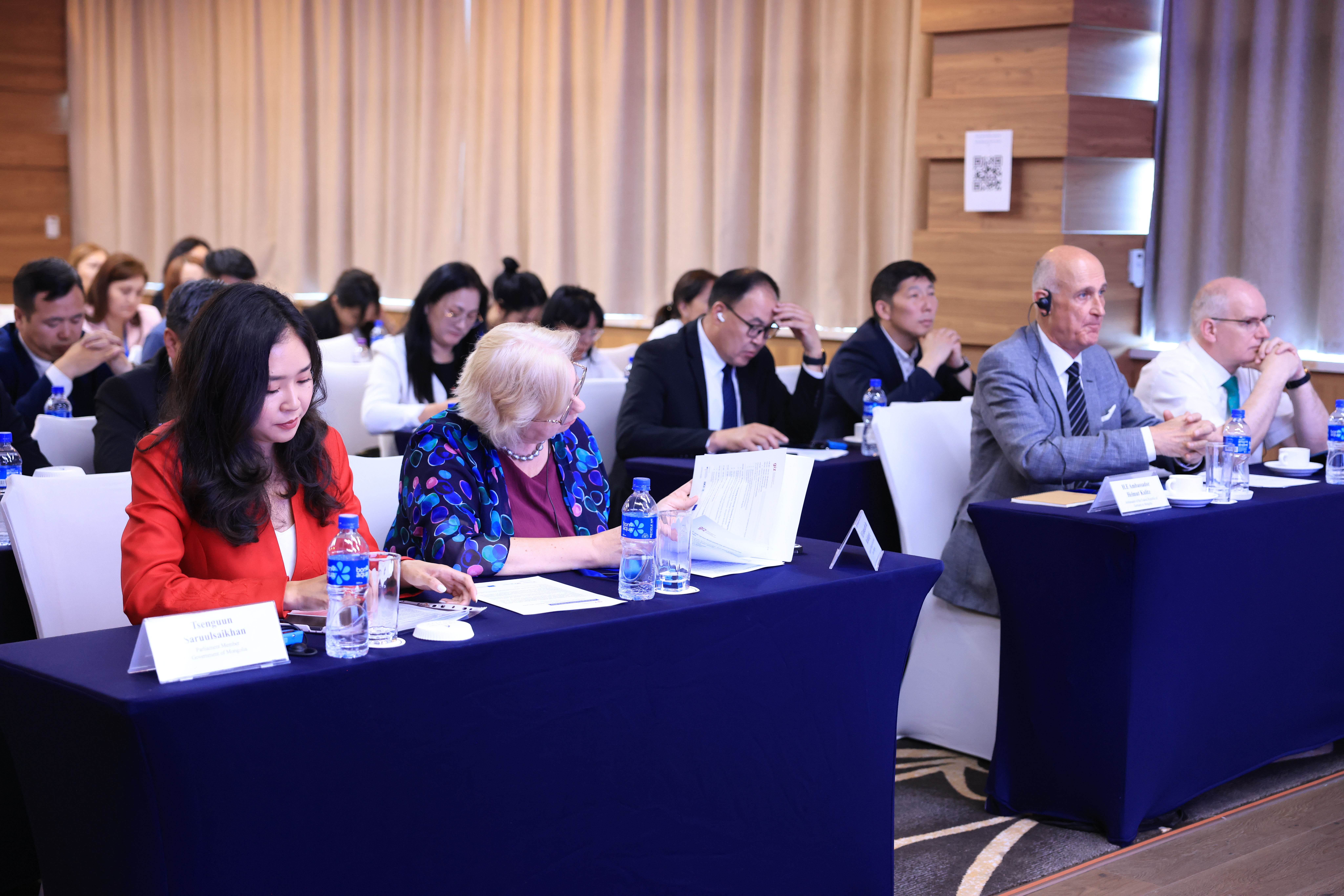
On 27 June 2025, the Just Energy Transition Forum (the JET Forum) took place in Ulaanbaatar, Mongolia. The forum brought together local, national, and international stakeholders from public and private sectors and academia. Objectives included exploring the current state of Mongolia’s energy sector and the potential for a just energy transition, highlighting the efforts of the historically coal-dependent region of Nalaikh in adopting and implementing its Just Energy Transition Strategy Nalaikh 2040.
The diverse group of speakers included a member of the Mongolian Parliament, ambassadors, as well as representatives from different ministries, the National Center for Public Health, the United Nations Development Programme (UNDP), mining company Oyu Tolgoi, the German-Mongolian Institute for Resources and Technology (GMIT), representatives from Nalaikh District Government, and further participants from the public and private sector.
Insights
The forum opened with a keynote speech by Member of Parliament Tsenguun Saruulsaikhan, who emphasised the importance of the JET Forum as a platform for exchanging views on the path towards a just energy transition in Mongolia. She expressed gratitude to the German Government and the European Union (EU) for their support of Mongolia’s energy transition and emphasised the need for Mongolia to take urgent steps towards the transition.
In her opening remarks, Ambassador Ina Marciulionyte, from the EU delegation to Mongolia, emphasised that the EU is ready to support Mongolia in the energy transition. She said that she would welcome clear political messaging from the Mongolian side on its willingness to move away from coal, and she encouraged the Mongolian government to be more decisive on reforms. Finally, she invited stakeholders to attend the Mongolia-EU Business and Investment Forum in Ulaanbaatar on 13–14 October 2025.
Next, German Ambassador Helmut Kulitz stated that Mongolia could lead by example in the region. He emphasised that an energy transition is about more than simply replacing coal with wind or solar – the “just” part is a key element that requires the involvement of communities, workers, and broader society. He agreed with Ina Marciulionyte that a clear political vision is needed for coal regions, as well as a clear commitment by the Government of Mongolia.
Enkhtur Jambal, the head of the Economy, Finance, and Investment Department in the Ministry of Family, Labour, and Social Protection, welcomed the event as an important opportunity to exchange views. He appreciated the collaboration between the ministry, as the political partner, and the Innovation Regions for a Just Energy Transition (IKI JET) project. Yalalt Sukhbaatar, head of the Nalaikh District Citizens’ Council, added that collaboration with the IKI JET project was also very important at the district level. He emphasised that in a just transition, no one should be left behind at the community level.
In the first session, input on the advancement of a Just Energy Transition in Mongolia were given from different perspectives, including the Ministry of Energy, UNDP, Oyu Tolgoi, and Mongolia’s National Center for Public Health.
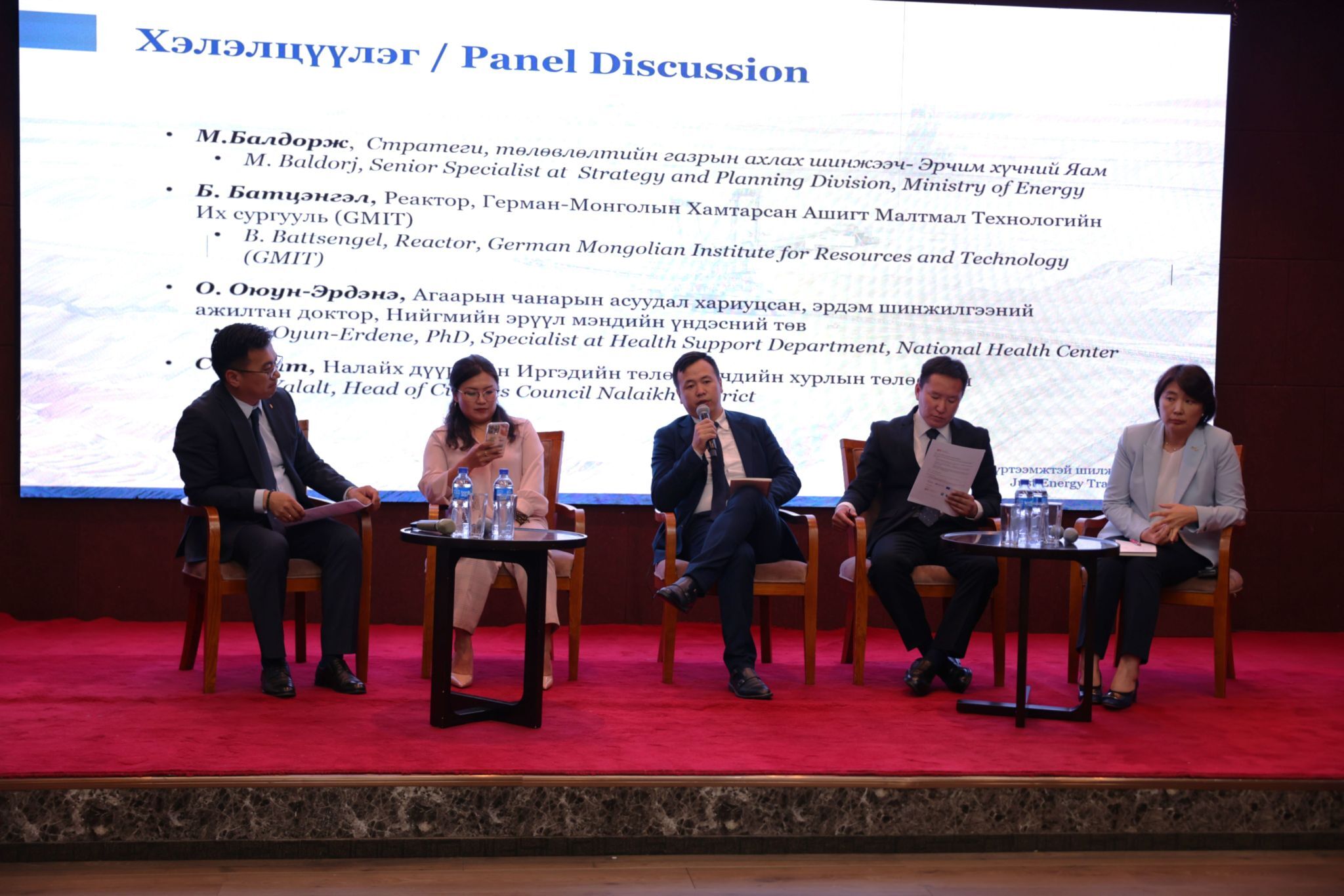
Baldorj Myagmarsuren, a senior specialist at the Strategy and Planning Division of the Ministry of Energy, began the session by providing an overview of Mongolia’s energy sector, highlighting the country’s reliance on coal for both electricity and heat generation. He predicted that there will be a substantial increase in energy demand due to economic development, and that from 2035, this increase could lead to a major shortage of power if energy production does not keep pace. New energy sources are needed, he said, stating the importance of international financial support to extend the ageing energy system. For example, the European Bank for Reconstruction and Development (EBRD) is engaged in upgrading the grid between Sainshand and Choir, an important corridor connecting Ulaanbaatar with the country’s southeastern region.
Baigalmaa Chinbat, a national project manager for the Acceleration of Just Energy Transition in Mongolia project, UNDP, stated that Mongolia’s energy transition must balance environmental, social, and economic priorities. She highlighted that while the country has vast renewable energy potential, only 0.06% is currently being utilised. Over 80% of electricity comes from coal, much of it from outdated infrastructure, resulting in high carbon dioxide (CO₂) emissions and severe air pollution. Nearly 80% of winter air pollution in Ulaanbaatar comes from ger districts (informal residential areas located on the outskirts of cities, especially in the capital, Ulaanbaatar, named after the traditional “ger” or yurt), where people spend a significant amount of time heating their homes, often using raw coal. That time, she noted, could be better used for education, work, or other productive activities.
Saintulga Munkhgerel, a senior manager of decarbonisation strategy at Oyu Tolgoi, outlined the mining company’s decarbonisation approach within the context of Mongolia’s broader energy transition. He emphasised the commercial drivers behind the strategy, including rising expectations from international financiers, and regulatory developments (such as the EU’s Carbon Border Adjustment Mechanism [CBAM]). Oyu Tolgoi’s emissions profile is largely shaped by energy use, with 80% of emissions being energy-related and 70% of diesel consumption linked to open-pit operations. In response, the company has begun offsetting 66% of its power emissions through Rio Tinto’s renewable energy certificates and is targeting significant reductions by 2030, with the goal of reaching net-zero emissions by 2050, using a 2018 baseline. The strategy focuses on diversifying power sources, phasing out fossil fuels (such as through equipment electrification and hybrid vehicles), and supporting domestic carbon offset projects. Oyu Tolgoi is also working with suppliers to encourage emissions measurement and integrate sustainability into procurement processes, reflecting the broader shift faced by the mining sector in adapting to a low-carbon economy.
Oyun-Erdene Otgonbyamba, a specialist in the Health Support Department of the National Center for Public Health, addressed the severe public health impacts of air pollution in Ulaanbaatar. With 80% of pollution originating from coal combustion and 20% from traffic, the city faces especially hazardous air quality during the winter months. This has led to a rise in respiratory and cardiovascular diseases, especially among children. Alarmingly, in Mongolia, the mortality rate linked to air pollution is twice the global average. In response, the government has set a target to reduce air pollution by 80% by 2030 through measures such as stricter air quality standards, expanded use of clean energy, improved healthcare services, and enhanced monitoring of pollution. Oyun-Erdene Otgonbyamba underscored the importance of aligning Mongolia’s air quality standards with the World Health Organization’s updated guidelines and called for a shift in focus, from merely reducing pollution to actively improving air quality, including through the promotion of clean energy solutions.
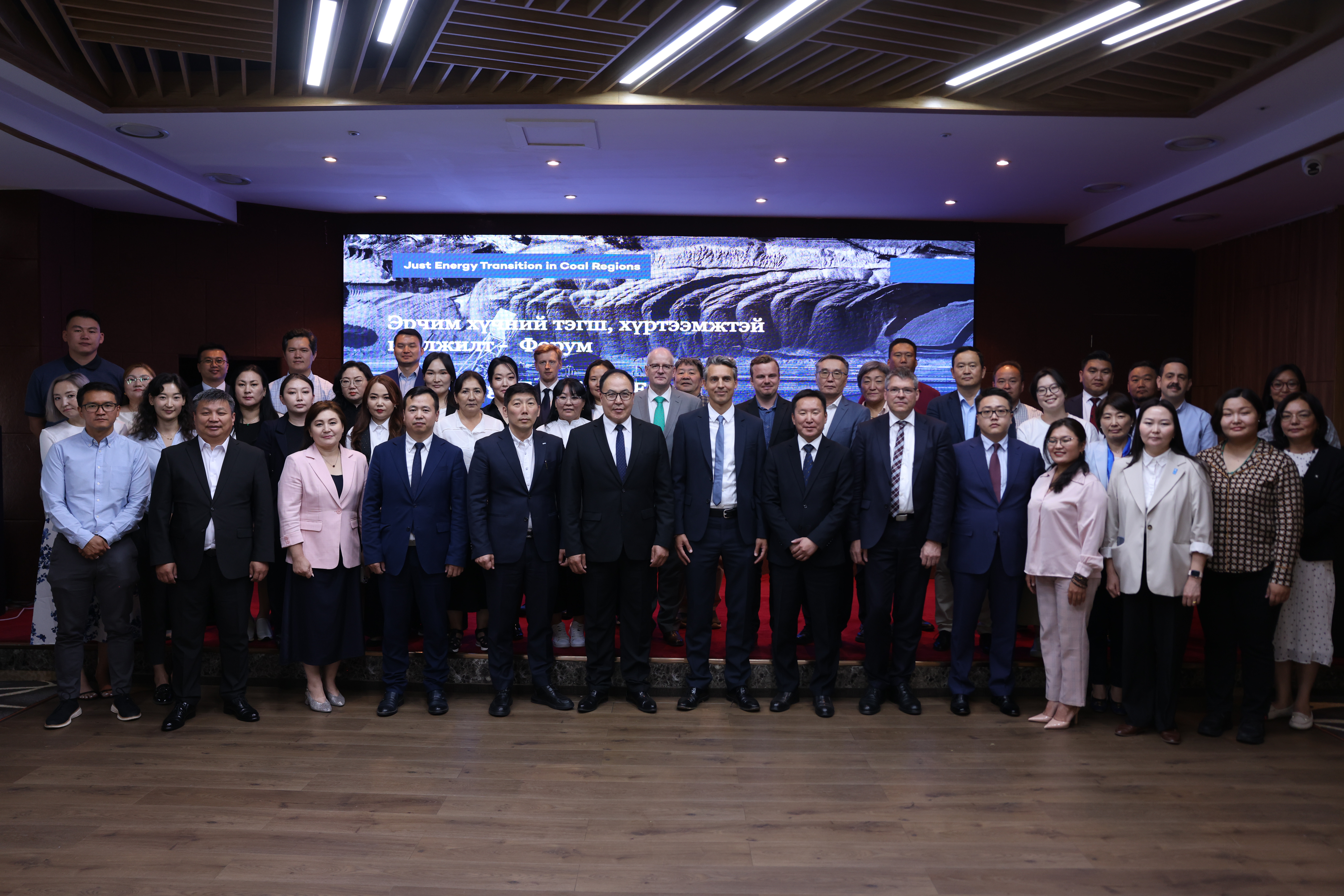
Session two focused on the just energy transition in the district of Nalaikh. It began with a presentation by Yalalt Sukhbaatar, head of the Citizens’ Council, who outlined Nalaikh’s vision of becoming a green city. A key challenge facing the district is its ageing thermal power plant, which is struggling to meet heating demands. As part of its 4-year action plan for renewable energy, Nalaikh is aiming to develop a 100-hectare solar park to address growing electricity needs, along with a 50-MW battery energy storage system connected to the central regional Nalaikh substation.
Gantuya Ganbat, professor of environmental engineering at the German-Mongolian Institute for Resources and Technology (GMIT), presented GMIT’s green university model and ongoing research initiatives. Among the projects she highlighted was a study on the use of coal combustion by-products, fly ash in particular, for backfilling and rehabilitating abandoned small-scale coal mines. She noted that this research directly addresses the environmental challenges posed by the old underground coal mines in Nalaikh District, as discussed by the previous speaker.
In his keynote, Philipp Schattenmann, project lead for the IKI JET initiative, challenged conventional assumptions about Mongolia’s energy future, envisioning Mongolia as a regional green powerhouse that exports clean electricity instead of importing it from Russia and China, hosts carbon-neutral data centres, and uses waste heat and sand battery storage for urban heating. Backed by real-world data and global trends, he stressed that the biggest risk is not the transition itself, but underestimating its speed and impact. Following his remarks, Bujinlkham Nyamaa, advisor for the IKI JET project in Mongolia, introduced the initiative’s work supporting coal regions in sharing knowledge across borders and co-creating inclusive, locally driven pathways towards resilient, post-fossil economies. She highlighted the project’s focus on turning the challenges of transition into opportunities for sustainable development through collaboration, innovation, and strong community engagement.
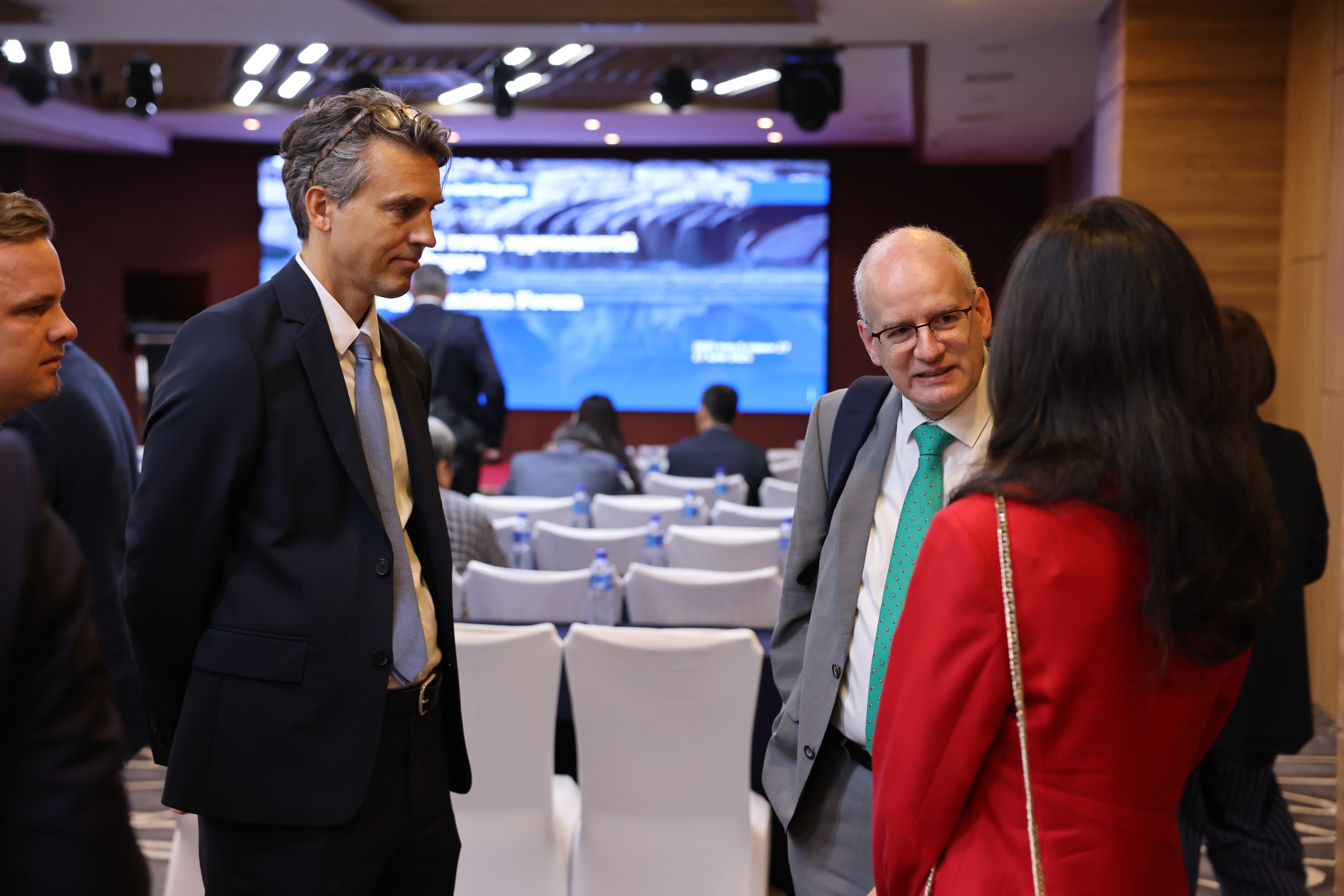
Throughout the event, there were lively discussions between the audience and the panellists. For example, in response to a question about the main challenges in expanding renewable energy, Baldorj Myagmarsuren from the Ministry of Energy pointed to the national grid as a critical barrier. He noted that the grid is outdated and lacks sufficient capacity, making it difficult to fully harness Mongolia’s renewable energy potential. According to him, the infrastructure is 20–30 years behind that of developed countries. He added that while creating plans is relatively straightforward, the real challenge lies in implementing them, especially when considering the country’s limited financial resources.
Referring to the financial dimension of a just energy transition, Baigalmaa Chinbat from the UNDP noted that many international and national financial institutions, including development banks, have shown strong interest in supporting Mongolia’s energy transition. However, she stressed that the absence of a coherent national strategy remains a key obstacle, especially given the government’s continued heavy subsidies for coal.
During the discussion, participants highlighted the importance of energy efficiency and public awareness in advancing the energy transition. One example raised was the common practice of residents in apartment buildings opening windows during winter to regulate indoor temperatures, rather than adjusting the heating, pointing to a need for behavioural change alongside technical solutions. Representatives from the private sector also recommended improving internal communication within the Ministry of Energy to enable more efficient and timely project planning. In addition, they pointed out that lengthy procedures and unclear regulatory requirements remain major barriers to the implementation of renewable energy projects.
In the closing remarks, Philipp Schattenmann emphasised that a just energy transition is inherently a multi-sectoral effort and welcomed the wide range of perspectives shared at the JET Forum. He concluded by echoing EU Ambassador Ina Marciulionyte’s sentiment that a just energy transition requires a shared commitment and sustained energy from everyone involved.
Stay Informed and Engaged
Subscribe to the Just Energy Transition in Coal Regions Knowledge Hub Newsletter
Receive updates on just energy transition news, insights, knowledge, and events directly in your inbox.
